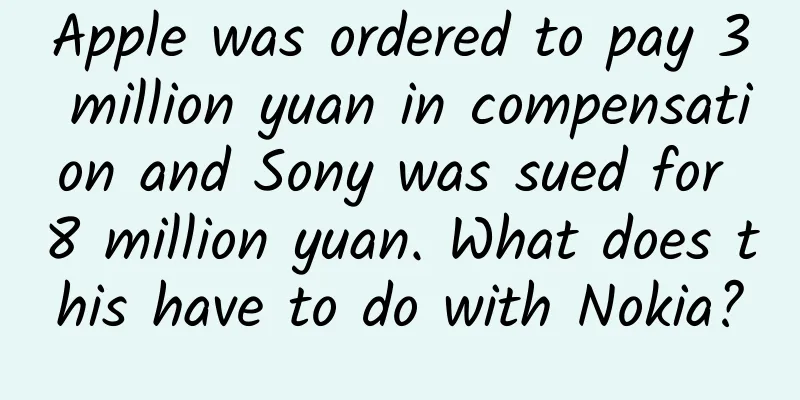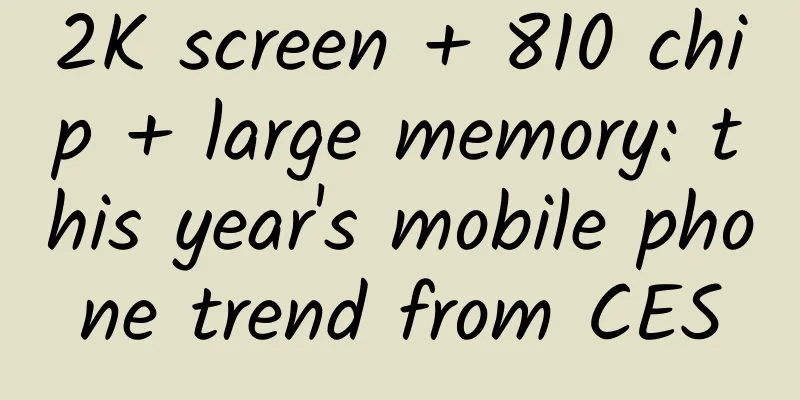Apple was ordered to pay 3 million yuan in compensation and Sony was sued for 8 million yuan. What does this have to do with Nokia?

|
"Black technology" and "subversion" are words that domestic mobile phone manufacturers such as Xiaomi and Meizu often mention. But the reality is that among the domestic mobile phone manufacturers who like to brag, brag and engage in marketing, there are probably only a handful of "black technology" patents or "disruptive innovation" technologies that they can truly show off and that belong to them. Even if there are a few decent patents or technologies, very few can generate revenue through licensing. On the contrary, traditional mobile phone giants like Nokia, which are often "badmouthed" or "looked down upon" by domestic mobile phone manufacturers, although no longer directly provide mobile phone production, manufacturing or sales to consumers, can still use their previously accumulated patents or technologies to influence other smartphone manufacturers and then affect end users. And this is the real focus that domestic mobile phone manufacturers should pay attention to and be vigilant about, whether it is to make money from marketing price difference, brand price difference, or technology price difference. Although Nokia no longer produces mobile phones. However, Nokia's influence on the mobile phone market does not seem to have diminished. In October 2016, the U.S. District Court for the District of Delaware ruled that Apple had infringed the "polite-ignore" mobile phone call muting patent held by MobileMedia Ideas and ordered Apple to pay $3 million in compensation. In November 2016, Wireless Future Technologies Inc. sued Sony Mobile in the Nanjing Intermediate People's Court, requesting the court to order Sony Mobile to pay RMB 8 million in compensation and stop selling the two infringing Xperia Z5 phones. These are two lawsuits related to mobile phones, one between China and the other between the United States. One is against Apple and the other is against Sony. One was awarded compensation in U.S. dollars and the other in RMB. However, there is a common figure behind these two lawsuits - Nokia. So, how did Nokia, which in many people's eyes has "fallen from the altar" or been "crushed" by smartphones, still maintain its influence on the mobile phone market after withdrawing from direct competition in the mobile phone market? What experiences and lessons should domestic mobile phone manufacturers learn from it? Robbery of Apple: Nokia's holding company spent six years and claimed 18 million in compensation, and was finally awarded 3 million In 2010, Mobile Media Ideas filed a lawsuit in the Delaware District Court, claiming that Apple infringed its 16 mobile phone patents and requested the court to order Apple to pay $18 million in damages. In December 2012, a jury in the U.S. District Court for the District of Delaware unanimously ruled that the three patents held by MobileMedia Ideas (covering "camera phones," "call processing," and "call rejection") were valid and that Apple's iPhone series of mobile phones infringed on these three patents. In September 2016, the U.S. District Court for the District of Delaware ruled that Apple's iPhone 3G, 3GS and 4 models infringed the "polite-ignore" mobile phone call silent call rejection technology patent held by Mobile Media Ideas, and ordered Apple to pay $3 million in compensation. Obviously, from the initial claim of US$18 million to the final award of US$3 million, judging from the amount of compensation, the impact on Apple or the iPhone should be very limited. However, the case deserves attention because MobileMedia Ideas was actually jointly funded by Nokia, Sony and Tagivan. On the one hand, the company holds a portfolio of more than 300 patents related to "call processing, speed dialing, database search, audio download and playback, and still image and video processing", a large portion of which were transferred from Sony or Nokia. For example, the patent related to call rejection mute processing, which was ultimately determined to be infringing on the Apple iPhone, was originally applied for by Sony and later transferred to MobileMedia Ideas. On the other hand, traditional mobile phone giants such as Nokia can continue to obtain commercial returns from technological innovation and reduce their own patent management costs by transferring their accumulated patent technologies to third-party companies as capital. Obviously, although Nokia is no longer engaged in mobile phone production, manufacturing and sales, it can still accumulate patents through technological innovation to influence the mobile phone market or profit from it, and this is the key point that domestic mobile phone manufacturers should seriously study or actively emulate. Suing Sony: Canadian company seeking $8 million and requesting suspension of sales used Nokia patents In November 2016, Sony Mobile was sued by a company called Wireless Future Technologies Inc. to the Nanjing Intermediate People's Court for alleged patent infringement. The company requested the court to order Sony Mobile to compensate for losses of 8 million yuan and to ban the sale of Sony Mobile's two Xperia Z5 phones. There are two points worth noting about this case. First, this is the first time that a foreign NPE organization has brought the patent litigation war to China. Second, the patent used to sue Sony Mobile for infringement actually came from Nokia. NPE institutions choose to file lawsuits against mobile phone manufacturers in China. Once the "testing the waters" effect is obvious, it will inevitably open a "Pandora's box" for NPE institutions to directly encircle and suppress smartphone manufacturers in China. This is obviously a trend that domestic mobile phone manufacturers have to guard against. Judging from the patents involved in the case, the patent that Wireless Future Technology sued Sony Mobile for is China authorized patent ZL200880022707.5 (CN101689884B), entitled "Control Channel in Communication Network System", which was actually applied for by Nokia Siemens Communications in 2008. It is worth mentioning that Wireless Future Technologies Inc. is a subsidiary of Canada's Wi-LAN, which has a record of patent transactions with Nokia. In July 2014, Canadian Wi-LAN signed a patent licensing agreement with Nokia regarding wireless technology-related patents involving "CDMA, WCDMA, GSM-related patents, HSPA and 4G/LTE technologies". At the same time, the two parties also reached a patent purchase agreement, whereby Wi-LAN will acquire some of Nokia's wireless communication technology patents related to mobile phones. Statistics from the website of the State Intellectual Property Office show that "Wireless Future Technology Company" has obtained a total of 22 patents related to wireless communication technology from Nokia. Obviously, through cross-licensing and sales of patents, Nokia has not only ensured that its specific businesses can use specific technologies without infringing on others' rights, but also enabled it to monetize its past R&D investments through methods other than production, manufacturing or sales. Invisible giants: Although Nokia and other manufacturers have withdrawn from the mobile phone industry, their influence cannot be underestimated Statistics from the website of the State Intellectual Property Office show that as of November 17, 2016, Nokia had published 8,382 inventions in China, 7 more than OPPO, 1.6 times that of Xiaomi, 5.8 times that of Gionee, 7.5 times that of vivo, and 9.3 times that of Meizu. Nokia's number of invention authorizations in China is 4,436, which is 4.7 times that of OPPO, 9.6 times that of Xiaomi, 42.3 times that of Gionee, 76.5 times that of vivo, and 130.5 times that of Meizu. It can be seen that in terms of patent layout, domestic mobile phone manufacturers are narrowing the gap with traditional mobile phone giants such as Nokia, but in terms of patent accumulation, most domestic mobile phone brands that often talk about "black technology" and "subversion" still have a huge gap with traditional mobile phone giants such as Nokia. More importantly, from the perspective of profit model, although most domestic mobile phone brands have amazing sales, they do not earn technology premium, but more from marketing premium and brand premium. Simply put, the value is not generated by their own technological innovation, but by transaction price differences caused by information asymmetry (such as low configuration and high price). Nokia's latest third quarter 2016 financial report shows that Nokia's revenue last quarter was 5.95 billion euros and the company's operating profit was 556 million euros (606 million US dollars). It is worth mentioning that thanks to the higher revenue generated by the intellectual property licensing business, Nokia Innovations Technologies' net sales in the third quarter of 2016 increased by 109% year-on-year, and its operating profit increased by 168% year-on-year. Judging from the growth in sales and operating profit alone, Nokia's revenue from patent licensing increased much faster than that of Nokia's other business categories. Simply put, although many traditional mobile phone manufacturers such as Nokia have withdrawn from the market, they are still influencing the development of the smartphone market and continuing to obtain continuous commercial returns from the mobile phone market or industry by "breaking down" their huge patent base into small pieces, either by selling it directly to related companies, charging licensing fees, or using patents as capital to establish companies. Nowadays, domestic mobile phone brands are catching up with giants such as Apple and Samsung in sales volume. At the same time, domestic mobile phone manufacturers should also seriously consider the focus of: how to make good use of technology iteration cycles such as 4G 5G and the domestic demographic dividend period to make money and accumulate technology or patents; more importantly, even if the business transforms in the future, they can still continue to obtain commercial returns from their own accumulated technological innovation. Simply put, the influence and commercial value of a brand is not determined by how many press conferences or concerts are held in a year or how many new mobile phones are released, but by how many so-called "black technologies" or "disruptive" technologies truly come from domestic mobile phone manufacturers. As a winner of Toutiao's Qingyun Plan and Baijiahao's Bai+ Plan, the 2019 Baidu Digital Author of the Year, the Baijiahao's Most Popular Author in the Technology Field, the 2019 Sogou Technology and Culture Author, and the 2021 Baijiahao Quarterly Influential Creator, he has won many awards, including the 2013 Sohu Best Industry Media Person, the 2015 China New Media Entrepreneurship Competition Beijing Third Place, the 2015 Guangmang Experience Award, the 2015 China New Media Entrepreneurship Competition Finals Third Place, and the 2018 Baidu Dynamic Annual Powerful Celebrity. |
<<: US regulators want phone makers to add driving mode, emulating airplane mode
>>: Li Shufu: Removing the steering wheel is extremely irresponsible for autonomous driving
Recommend
Unveiling the 12306 team: Fighting against ticket machines for a year
[[219796]] On February 2, at the China Academy of...
Operations Uncle: Why did the “single dog attribute” flood the circle of friends overnight?
Last night, yes, it was last night, the operation...
Can eating less sugar reduce the risk of cardiovascular disease? Research shows: It depends on what kind of sugar you eat
Written by: Nan An It’s common to hear that “eati...
Alipay 2018 Five Blessings Collection is now open, so you can collect the Five Blessings faster!
As the Spring Festival approaches, Alipay’s annua...
Mistaking cancer for a cold, a 95-year-old patient regrets fatal negligence
Recently, a female patient born after 1995 in Sha...
Why are advertisements in 2020 becoming more and more addictive?
The lyrics say, "The only thing that never c...
2022 National Trend Marketing Rules!
Although the issue of national trends is always m...
National Malaria Day丨From 30 million cases to 0 cases, what did it take?
April 26th is the 15th National Malaria Day. Spea...
The formula for creating a hit product
This article combines the popular products in rec...
The most comprehensive summary of operation and promotion channels in history!
I believe this may be the most comprehensive prom...
Jiang Ziya's little secret! Did the small token help King Wu defeat King Zhou?
Communication in war is an extremely important li...
Who is the number one mobile phone in China?
Lenovo's own data shows that its domestic sma...
Guangzhou online medical consultation mini program function, how much does it cost to develop an online medical consultation mini program?
With the continuous development of informatization...
Some of the best tricks for iOS development
Some tips for iOS What should I do if TableView d...
The resumption rate of work in 24 cities exceeds 80%. What is the specific situation? Attached is a list of resumption rates in various regions!
As the epidemic situation eases, many areas have ...









